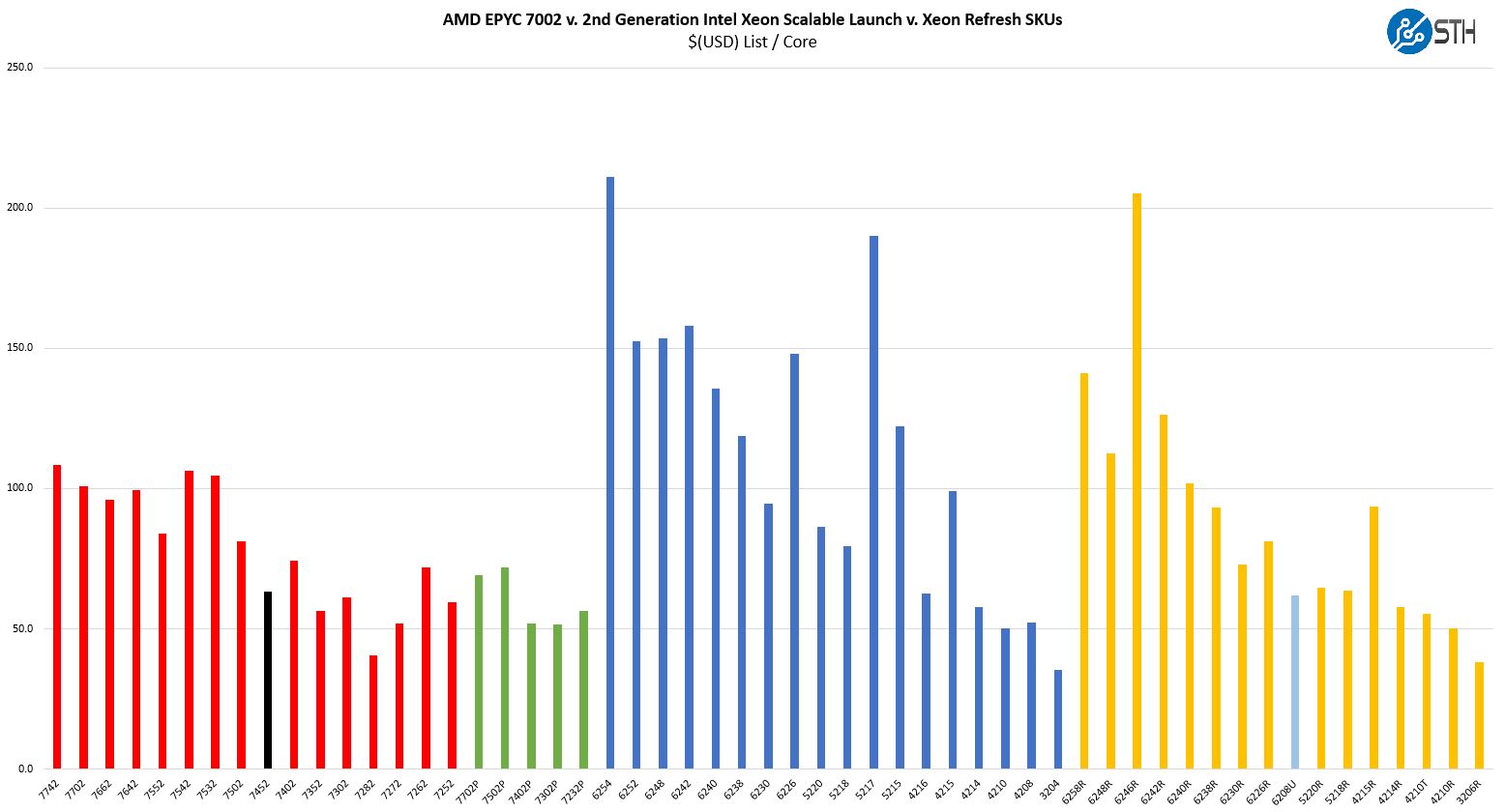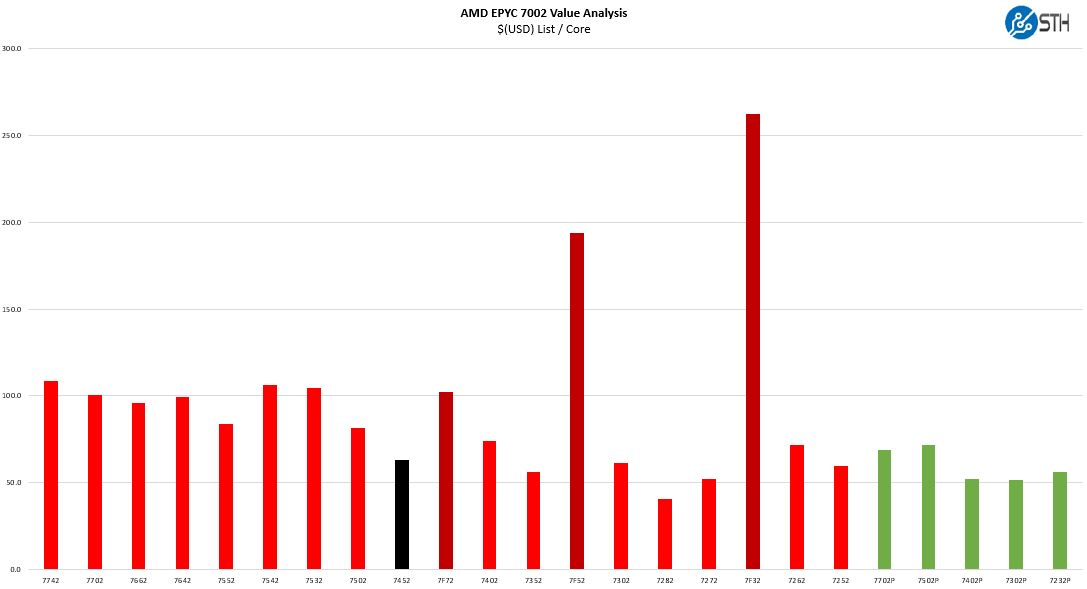AMD EPYC 7452 Market Positioning
Thes chips are not released in a vacuum instead, they have competition on both the Intel and AMD sides. When you purchase a server and select a CPU, it is important to see the value of a platform versus its competitors. Here is a look at the overall competitive landscape in the industry:

We are going to first discuss AMD v. AMD competition then look to Intel Xeon.
AMD EPYC 7552 v. AMD EPYC
With the addition of the Frequency Optimized EPYC parts, this chart has changed drastically.

While most parts are in the $100-110/ core range, even at the high-end, the frequency optimized parts cost much more on a per-core basis.
Even with that, the EPYC 7452 one can see at around $63/ core is a relative bargain in this range. Its immediate peers, as well as the SKUs further up the stack, are much more costly.
Although pricing is similar, we think that users who are looking for 32-core single-socket servers will be better served by using the AMD EPYC 7502P. That SKU is slightly more costly, but offers a higher TDP and more performance. At the same time, if that trade-off for higher clocks and TDP is not worthwhile, the EPYC 7452 is actually in the range of a viable 32-core single socket part even as a non-“P” SKU.
AMD EPYC 7452 v. Intel Xeon
Since the EPYC 7452 was launched in 2019, Intel made a strong competitive move in early 2020 with the Big 2nd Gen Intel Xeon Scalable Refresh altering the competitive landscape. Intel effectively dropped prices across most of its mainstream CPUs.
The challenge here is defining the Intel competition even with the Xeon Refresh. Intel still has a maximum of 28 cores per socket, which carried over to the 3rd Generation Intel Xeon Scalable Cooper Lake generation. The Intel Xeon Gold 6238R puts a 165W (similar TDP albeit 10W higher) into the same range as the EPYC 7452. Based on what we saw with the Intel Xeon Platinum 8276L, a similarly clocked and TDP SKU to the Gold 6238R but designed for 4-socket deployments, we think that AMD still has a competitive offering at a lower price.
The consolidation case is extremely interesting here. With 32 cores and a $63/ core list price it is actually in-line with the Intel Xeon Silver 4216 in terms of pricing. There is a case to be made that one can consolidate two Xeon Silver 4216 sockets to an EPYC 7452 socket and effectively need half as many servers. That can offer enormous TCO savings.
AMD offers a larger memory footprint with up to 4TB in 8-channel DDR4-3200 versus 1TB in 6-channel DDR4-2933. AMD has more PCIe I/O with 64, 96, or 128 PCIe Gen4 lanes per socket compared to Intel’s 48x PCIe Gen3 lanes. Intel has features such as AVX-512 and VNNI instructions (DL Boost) that AMD does not have but are new for 2nd Generation Intel Xeon Scalable. Perhaps the biggest feature Intel has is Optane DCPMM support. We should note here that DCPMM support is limited by memory capacity since the Gold 6238R is not a “L” SKU. Still, if one wants fast storage, DCPMM is a significant option that AMD does not have. If you are not using small DCPMM footprints, nor the new instructions, then AMD is extremely competitive.
Final Words
When we first saw the SKU stack, we likely had an oversight. We thought this SKU was simply a lower-power 32-core “Rome” offering. Instead, the AMD EPYC 7452 offers a truly unique consolidation case. While most processors we see in the AMD EPYC line focus on consolidating two higher-dollar per core processors such as the Xeon Gold or Platinum series, the EPYC 7452 is actually priced to consolidate Xeon Silver sockets by 2:1 or more.
We think a great use case for these is going to be in 2U 4-node systems where there can be power and thermal constraints. This gives server vendors the ability to offer 256 cores and 512 threads in a 2U 4-node server without going to extremes on cost or power consumption. Higher TDP and core count chips are nice, but some systems struggle with >200W TDP CPUs and have restrictions on features such as how many NVMe drives can be populated to still cool the higher-TDP CPUs.
Overall, we found the AMD EPYC 7452 to be an excellent chip. It may not be the best-performing chip in the EPYC lineup, nor even close to holding that title. What it does offer is higher-than Xeon core counts at a low TDP and a relatively low list price. Indeed, the pricing is more competitive with the Xeon Silver offerings than the higher-end Xeon Gold/ Platinum offerings AMD would compete with on a raw core count basis.




Seeing the performance of this chip and the other EYPC chips next to the Intel Xeon offerings got me thinking:
“Oh how the once mighty have fallen…”